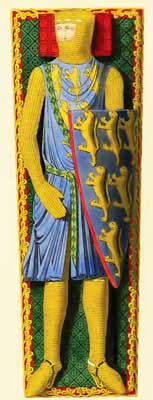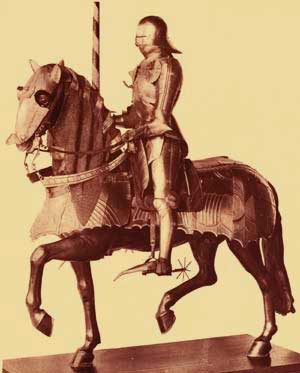The Armor of a Medieval Knight: Development Periods
Medieval armor history can be analyzed also by type, resulting in three main periods of development:
- The Age of Chain Mail: 1066 – 1277.
- The Transition Period: 1277 – 1410. A distinct period during the transition was the Camail age.
- The Plate Armor Age: 1410 – About 1600.
Chain mail armorThe chain mail armor period is named after what was the most common technique of armor construction between the Norman invasion of England and about 1277. However, there were variations like banded mail, and the scale armor, which consisted of pieces of metal (scales) sewn upon a leather or quilted garment. To protect against injury, the upper row was overlapping the lower. The scales could have different shapes: with the lower edge rounded, like the scales of a fish, feather-shaped, or square.
The old name of “trellice” coat designates another type of armor reinforcing the leather protection. The Medieval draughtsmen represented the trellice by diagonal lines, probably thongs applied to the groundwork with metal studs riveted in the intervening spaces. This design of lines is very common on the Bayeux Tapestry.

Armor of a Knight - 13th Century
William Longuespée
First Earl of Salisbury
A variety of Medieval armor seen in early illuminated manuscripts is the ”ringed” type. It is quite probable that the circular discs may have been solid, even if, practically, the ring is much lighter and gives equal protection against a cutting blow.
At the beginning of the 13th Century, the hauberk of chain mail was made with a top-flattened continuous coif and gloves not divided into fingers. We show here a superb example of this type of hauberk, together with the sleeveless surcoat.
Knight's armor componentsThe garments composing the knight armor were the tunic, the gambeson, the hauberk, the chausses, the chausson, and the surcoat.
Various accessories like the ailettes, coudieres, poleyns, and greaves were introduced gradually. The first garment put on by the knight was the tunic, a short linen shirt, which could reach just above the knee. Next was the gambeson, the quilted garment preventing the chain mail from bruising the body. Then followed the hauberk, the chausses, the chausson, and the surcoat.
The Transition periodThe armor of this period was of a mixed construction, combining mail with plate. During the 14th century, the knights were still wearing the gambeson under the mail armor, and the legs were protected sometimes with a metal-studded or pourpointed defence. Iron was used for the mail and scale armor. It was also employed in making a pliable defence, the “splinted” armor, which eventually became the brigandine of a latter period. As the drawings and monuments are testifying, banded mail was still in use until the end of the 14th century.
Leather, either in its natural state or boiled and then allowed to dry hard, was frequently used in armor construction. The boiled variety was called (from French), cuirbouilli. It was much lighter than the metal, however it was exceedingly hard. Due to its qualities, it was extensively used for tournaments, and for barding, the armor of the knight's horse.
Besides the "plastron de fer" (worn mostly under the surcoat), the first visible plate defence added to the chain mail was the poleyne or knee-cop. The possible reason why this was the first plate enforcement of the armor may be the fact that at the time the Knight's shield became shorter, and, when mounted, he also had his knees exposed to the attack of the foot soldiers. It was frequently made of cuirbouilli.
At the end of the 13th century the armor was provided with new features, like the appendages known as ailettes. The Setvans Brass reproduced here is showing both the poleynes and the ailettes. Some authors considered them as having ornamental purposes, as many were decorated with heraldic blazons. However, there are representations of plain ailettes worn in battle, and they might have been intended as shoulder guards.
The next addition of plate to the mail armor was intended to protect the knight's legs. As early as 1289, the front of the leg was entirely protected by plates made either of metal or cuirbouilli. The plate additions were gradually increased. Besides the poleynes and the ailettes, plate jambs were used on the legs, and the arms were protected by plates and circular discs on shoulder and elbow. After 1325, the ailettes were rarely used.

Mounted Knight in Plate Armor
15th Century
The solerets are among the earliest examples of laminated plates used in the Medieval armor construction. Protecting the feet, they were made of strips of metal riveted upon leather for ease of movement.
The Camail armorIn the “Camail” period (1360-1405), a knight's armor could be almost entirely of plate. Almost, because the hauberk was still worn beneath, and the "défaut de la cuirasse" (the armpit area) was still not protected by plate. However, in some instances, this vital spot was defended by a circular, oval, crescent-shaped, or square plate attached by laces.
In the Camail age, the most popular head protection was the bascinet, which eventually evolved into a more advanced construction, the visored (or pig-faced) bascinet, having a movable visor.
The Great Helm of the 14th century is similar to those seen at the end of the late 13th century, having the sugar-loaf shape or that of a cylinder surmounted by a truncated cone. The helm was usually worn over the bascinet, in which case, the visor of the latter was completely removed.
In the 15th century, the knight armor was entirely made of plate. The plate armor period began about 1410.


